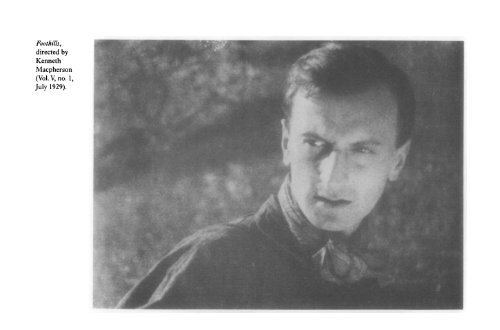close up - Monoskop
close up - Monoskop
close up - Monoskop
Create successful ePaper yourself
Turn your PDF publications into a flip-book with our unique Google optimized e-Paper software.
THE CONTRIBUTION OF H.D. 103<br />
the work of the 'transcendentalists' Emerson and Thoreau, and in Poe, Hawthorne,<br />
Melville and Whitman. 44<br />
The dream of recapturing a prelapsarian, universal, pictographic language fed<br />
directly into early film aesthetics. Its chief North American exponent was the poet and<br />
critic Vachel Lindsay, author of the first book of film theory, The Art of the Moving<br />
Picture, published in 1915. 45 Here, as in his subsequent writings on cinema, The<br />
Progress and Poetry of the Movies, and in his poetry, Lindsay spelled out his vision of<br />
modern America (with its advertisements, billboards, newspaper photographs, signwritings)<br />
as 'a hieroglyphic civilization far nearer to Egypt than to England'. 46 In The<br />
Art of the Moving Picture, in which he painstakingly analyses a set of Egyptian<br />
hieroglyphs, their Roman letter equivalents and their equivalents in 'the movingpicture<br />
alphabet', 47 Lindsay writes:<br />
Because ten million people daily enter into the cave, something akin to Egyptian<br />
wizardry, certain national rituals, will be born. By studying the matter of being<br />
an Egyptian priest for a little while, the author-producer may learn in the end<br />
how best to express and satisfy the spirit hungers that are peculiarly American.<br />
It is sometimes out of the oldest dream that the youngest vision is born. 48<br />
The expatriate, European-identified, anti-Hollywood, avant-garde H.D.'s models of<br />
'universal culture' may seem remote from Lindsay's concerns with 'our America of<br />
Tomorrow', just as her habitual emphasis on hieroglyphic language as a coded, secret<br />
knowledge is apparently at odds with a model of hieroglyphics as, in Nick Browne's<br />
words, 'a mode of reading that bypasses critical judgement'. 49 There are, nonetheless,<br />
interesting links between these two poets and writers on film, not least their<br />
Swedenborgian perceptions of the power of'light' and of the world as a 'grammar of<br />
hieroglyphs'. 50 The issue is less, however, the echoes of Lindsay's film-writing in<br />
H.D.'s. It is rather their shared, as well as disparate, relationships to the complex<br />
representations of film culture and language in the early twentieth century, and to the<br />
national, racial, democratic and commercial ideologies which these articulated -<br />
which could be gathered under, in Miriam Hansen's phrase, the 'ambiguous<br />
celebration of film as a new universal language, as a historically unique chance to<br />
"repair the ruins of Babel"'. 51<br />
In her brilliant reading of D.W. Griffith's Intolerance (a film which represents<br />
history, culture and 'race' through writing-systems, inscriptions, Babel-languages,<br />
'writings on the wall'), in the context of early cinema and the public sphere, Hansen<br />
states: 'If Intolerance is proposing to recover a unity of popular and high art, it does so<br />
not by replacing writing with a s<strong>up</strong>erior language of visual presence, but by retrieving<br />
the common roots of both film and literature in the hieroglyphic tradition.' 52 This also<br />
works well as a way into H.D.'s conceptual strategies. It allows us to move beyond the<br />
opposition H.D. offers in Tribute to Freud-the (non-)choice between 'the writing on<br />
the wall' she saw in Corfu as 'symptom or inspiration' 53 - and to understand her focus<br />
on inscriptions and hieroglyphs as a form of cultural theorizing, whose roots may well<br />
lie in the Transcendentalist tradition of 'American hieroglyphs' and its understanding<br />
of hieroglyphics as both esoteric script and populist communication.

















